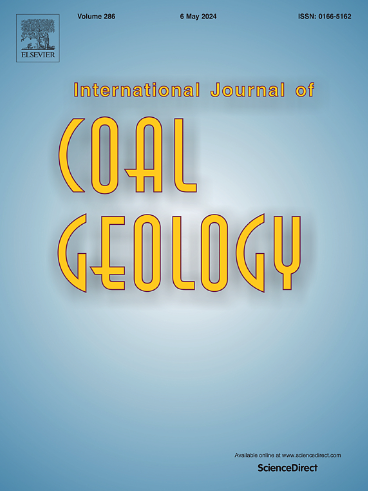中低阶煤中不同类型可溶有机质特征:富焦油煤热解过程中焦油生成和运移的意义
IF 5.7
2区 工程技术
Q2 ENERGY & FUELS
引用次数: 0
摘要
中低阶煤中的可溶性有机质可分为游离态(FSOM)、矿物伴生态(MSOM)和化学伴生态(CSOM)。然而,在富焦油煤的研究中,这些不同类型的SOM的特征仍然知之甚少,主要是因为长期以来人们认为煤是一种常规的气源岩。研究了不同类型有机质的地球化学特征及其连续处理后残渣的分子结构特征,探讨了有机质成熟度和焦油产率对这些特征的影响,阐明了热解焦油的生成和运移机理。从鄂尔多斯盆地采集了9种不同成熟度和焦油产率的中低阶煤,对其进行了连续处理,得到了FSOM、MSOM和CSOM。有机特征对比表明:(1)有机质含量依次为FSOM>; CSOM>; MSOM。FSOM和MSOM主要由芳烃组成,而沥青质是CSOM的主要成分。(2)有机质极性顺序为CSOM>; MSOM>; FSOM极性受有机质成熟度和焦油产率的影响,而CSOM极性主要受物质来源的影响。(3)有机质成熟度表现为CSOM>; MSOM>; FSOM,有机质成熟度和焦油产率共同影响有机质地球化学特征。分子结构特征比较表明:(1)各SOM组分氧官能团含量逐渐增加,脂肪官能团含量逐渐减少。(2)有机质成熟度和焦油产率对分子结构均有影响。综合比较有机地球化学和分子结构特征发现:(1)CSOM的基团组成受芳香官能团和羟基官能团的显著影响。(2)富焦油煤热解过程中游离烃主要来源于FSOM和MSOM。(3)热解焦油运移路径依次为硅酸盐矿物-碳酸盐矿物-孔隙-排液。这些差异为理解热解焦油的生成和运移机制提供了新的见解。本文章由计算机程序翻译,如有差异,请以英文原文为准。
Characteristics of different types of soluble organic matter in low- to middle-rank coals: Implications for tar generation and migration during tar-rich coal pyrolysis
Soluble organic matter (SOM) in low- to middle-rank coal can be categorized into free (FSOM), mineral-associated (MSOM) and chemical-associated (CSOM) states. However, the characteristics of these different types of SOM remain poorly understood in tar-rich coal research, primarily due to the long-standing perception of coal as a conventional gas source rock. This paper investigates the geochemical characteristics of different types of SOM and the molecular structure characteristics of their residues after successive treatments, discusses the influence of organic matter maturity and tar yield on these characteristics, and clarifies the generation and migration mechanisms of pyrolysis tar. Nine low- to middle-rank coals with different maturity and tar yield collected from the Ordos Basin underwent successive treatments to obtained FSOM, MSOM and CSOM. Comparison of organic characteristics reveals: (1) SOM content follows the order of FSOM> CSOM> MSOM. The FSOM and MSOM are primarily composed of aromatics, while asphaltenes are the main components of the CSOM. (2) SOM polarity follows the order of CSOM> MSOM> FSOM, the polarity of FSOM and MSOM is influenced by both organic matter maturity and tar yield, while the polarity of CSOM is primarily affected by matter origin. (3) SOM maturity shows the order of CSOM> MSOM> FSOM, the geochemical characteristics of SOM are influenced by both organic matter maturity and tar yield. Comparison of molecular structure characteristics reveals: (1) Oxygen functional group content gradually increases across all SOM fractions, while aliphatic functional group content gradually decreases across all SOM fractions. (2) Molecular structure is influenced by both organic matter maturity and tar yield. Comprehensive comparison of the organic geochemistry and molecular structure characteristics reveals: (1) Group composition of CSOM is significantly affected by aromatic and hydroxyl functional groups. (2) FSOM and MSOM primarily contribute to the free hydrocarbons during tar-rich coal pyrolysis. (3) Migration pathway of pyrolysis tar follows the order of silicate minerals, carbonate minerals, pores and expulsion. These differences provide new insights into the understanding of pyrolysis tar generation and migration mechanisms.
求助全文
通过发布文献求助,成功后即可免费获取论文全文。
去求助
来源期刊

International Journal of Coal Geology
工程技术-地球科学综合
CiteScore
11.00
自引率
14.30%
发文量
145
审稿时长
38 days
期刊介绍:
The International Journal of Coal Geology deals with fundamental and applied aspects of the geology and petrology of coal, oil/gas source rocks and shale gas resources. The journal aims to advance the exploration, exploitation and utilization of these resources, and to stimulate environmental awareness as well as advancement of engineering for effective resource management.
 求助内容:
求助内容: 应助结果提醒方式:
应助结果提醒方式:


